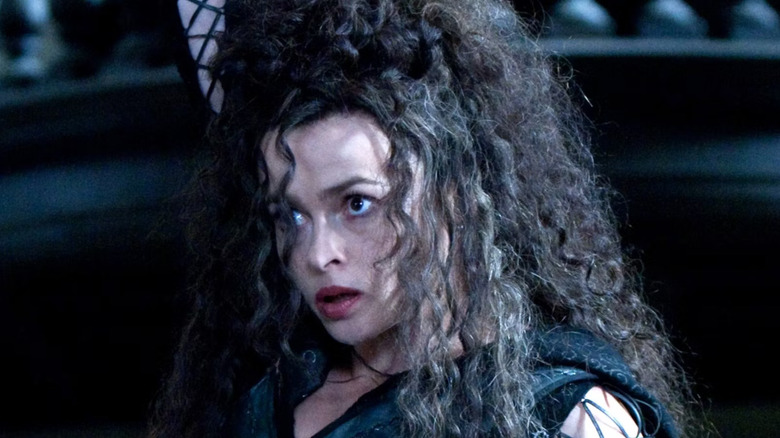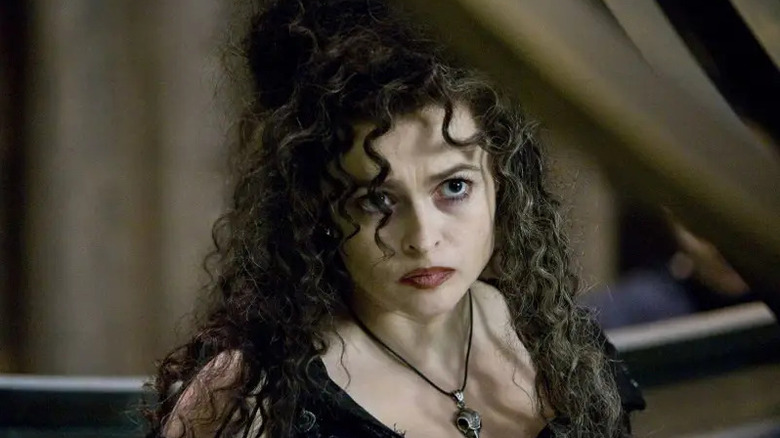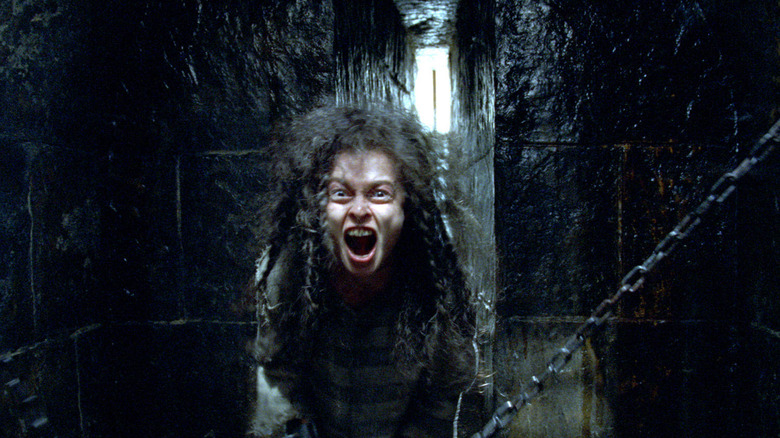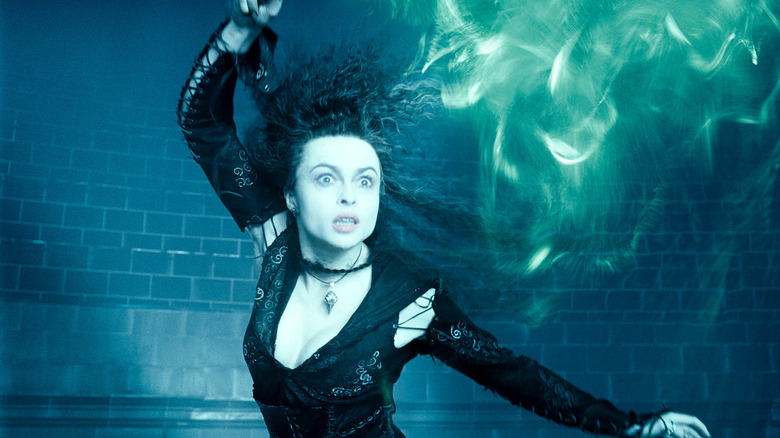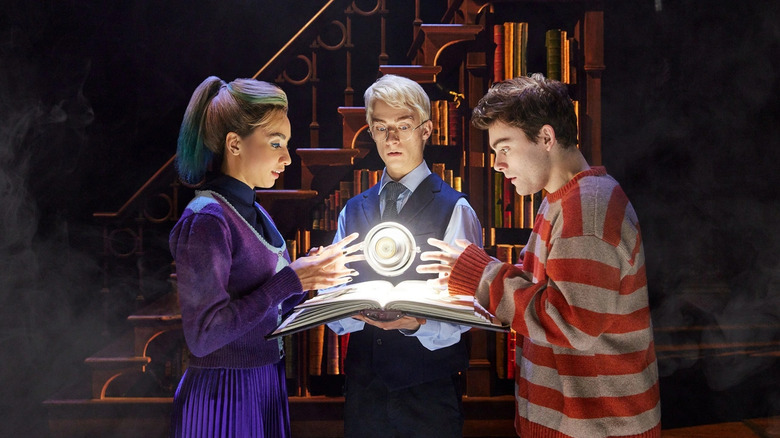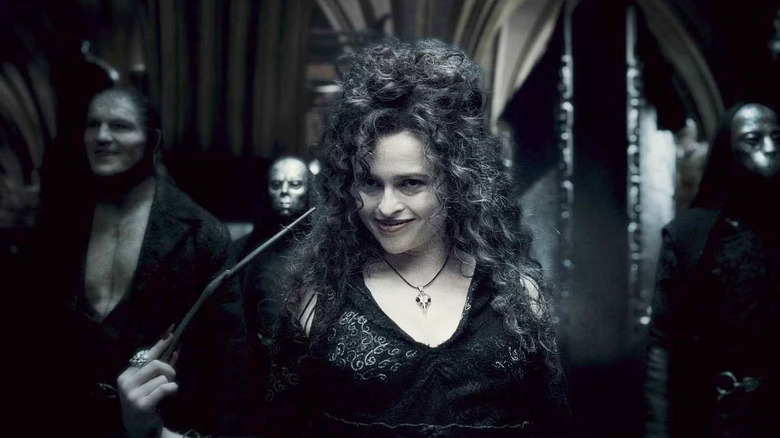The Lestrange Family Tree From Harry Potter Explained
There are a lot of villainous characters in the "Harry Potter" franchise, but the Lestrange family happens to house quite a lot of them. First introduced in "Harry Potter and the Goblet of Fire" (in the book, at least), the Lestranges are a deeply evil family — who share blood with other "pureblood" magical families — who align themselves with the Dark Lord Voldemort, ultimately played by Ralph Fiennes in the movies, more or less immediately. So what about the time before the fourth "Harry Potter" installment? Also, were any of the franchise's more beloved characters actually related to the Lestranges?
Regarding that second point, the answer is actually yes. Both Sirius Black (played by Gary Oldman) and Nymphadora Tonks (played by Natalia Tena), two of the series' "good guys," are related to the Lestranges, sort of. Bellatrix Lestrange — the main representative of the family in the franchise, who's played by Helena Bonham Carter — was actually born into the pureblood Black family, making her Sirius' cousin; her sister Andromeda Black is disowned by the rest of the family after marrying a Muggleborn wizard named Ted Tonks and having their half-blood daughter Nymphadora. Narcissa Malfoy, portrayed by the late Helen McCrory, was also born into the Black family, making quite a lot of "Harry Potter" characters related to the Lestranges (at least by marriage), but for the most part, those who bear the name "Lestrange" turn towards evil deeds. (There's one exception, and we'll get to that momentarily.) So how can we make sense of the Black family tree?
The first notable Lestrange was a Minister of Magic — until Leta
It's fair to say that the Lestrange family, who had roots in France originally (and even have multiple burial plots in Paris' legendary and very real Père Lachaise Cemetery) weren't always bad, although they didn't get off to a great start with Rodolphus Lestrange, a Minister for Magic in 1800. Rodolphus' main act during his short reign as Minister was to attempt to shut down the Department of Mysteries, but nobody went along with his grand plan; he ended up resigning the role after just six years.
The next notable Lestrange to appear in the "Harry Potter" narrative is relevant to the "Fantastic Beasts" franchise — specifically, Corvus Lestrange, who enchants the married Laurena Kama (of the powerful Kama family) to fall in love with him. The two have a child, Leta Lestrange (we'll come back to her shortly), but Laurena dies in childbirth and Corvus marries his second wife, Clarisse Tremblay. With Clarisse, Corvus finally has a male heir, whom he also names Corvus, but as a young child, Leta switches Corvus with another child and puts her half-brother on a ship that ultimately sinks.
Leta eventually grows up and attends Hogwarts, and in "Fantastic Beasts: The Crimes of Grindelwald," we meet her as an adult, played by Zoë Kravitz. (She's seen briefly in a photograph in the first film, "Fantastic Beasts and Where to Find Them.") In "The Crimes of Grindelwald," Leta is killed during a confrontation with Grindelwald (Johnny Depp), using her last words to tell her schoolmate and friend Newt Scamander (Eddie Redmayne) that she loves him.
Bellatrix Black marries into the Lestrange family and allies it with Voldemort
Let's go back to Bellatrix Black, who definitely had some fairly evil tendencies well before marrying into the Lestrange family. Her husband, Rodolphus Lestrange (a different one, not the previously mentioned Minister for Magic) hung out with Bellatrix a lot during their shared time at Hogwarts School of Witchcraft and Wizardry, spending time with a group of friends that included future Death Eaters like Evan Rosier, two characters named Avery and Wilkes who never get official first names, and Severus Snape (a secret turncoat played in the movies by the late, great Alan Rickman). It's not entirely surprising, then, that when Bellatrix and her buddies graduate from Hogwarts, they join forces with Voldemort. (We don't hear directly from many Lestranges in the narrative, but the fact that most of them believe in pureblood supremacy, as does Voldemort, probably has a lot to do with it.)
In "Harry Potter and the Goblet of Fire," Harry, alone in Albus Dumbledore's (Michael Gambon in the film) office, sees the Hogwarts headmaster's Pensieve and decides to check it out; inside, he finds a memory chronicling the trial and subsequent arrest of Bellatrix, Rodolphus, Rodolphus' brother Rabastan, and Bartemius Crouch Jr. (David Tennant in the film). The three are on trial in the first place for torturing Aurors and Order of the Phoenix fighters Frank and Alice Longbottom, the absent parents of Harry's Hogwarts classmate and friend Neville Longbottom (Matthew Lewis), and this is the first time Harry full realizes what the Lestranges are capable of.
Bellatrix and Rodolphus are imprisoned in Azkaban but eventually escape
Helena Bonham Carter's portrayal of Bellatrix Lestrange first appears in the film adaptation of "Harry Potter and the Order of the Phoenix," where, thanks to the full return of Voldemort, Bellatrix and Rodolphus manage to escape their imprisonment in the remote wizard prison Azkaban. (The Minister for Magic at this time, Robert Hardy's Cornelius Fudge, is actively denying Voldemort's return in the first place, which more or less allows Azkaban's guards, the dementors, to ally with Voldemort and probably free a bunch of super-dangerous inmates. Good job, Cornelius.) Bellatrix is, in a word, terrifying. It's clear that she embraces chaos, anarchy, and Voldemort above all else, and that she'll stop at nothing to do her master's bidding and take down Harry and anyone aligned with him.
Bellatrix's bloodlust reaches a horrible zenith at the end of "Order of the Phoenix." As Bellatrix and a handful of Death Eaters face off against Harry and his friends deep within the Department of Mysteries — they're all squabbling over an orb containing a prophecy concerning Harry and Voldemort — members of the anti-Voldemort Order of the Phoenix arrive to save the day, including Harry's beloved godfather Sirius Black. Sirius and Bellatrix face off directly, and whether or not Bellatrix's curse kills Sirius is unclear; what is clear is that she sends him through a mysterious and magical veil in the Death Chamber, which itself would have killed him even if the curse didn't. Harry vows to kill Bellatrix on the spot but is stopped by members of the Order, and the moment marks Harry forever.
Bellatrix is killed during the Battle of Hogwarts, but her husband survives
Harry's quite understandable hatred for Bellatrix persists throughout the rest of the "Harry Potter" franchise, but the use of Bellatrix's identity ends up becoming key to Harry's mission to destroy all of Voldemort's Horcruxes. When Harry and his best friends Ron Weasley (Rupert Grint) and Hermione Granger (Emma Watson) learn that Helga Hufflepuff's cup, which contains a part of Voldemort's soul, is hidden within the Lestrange family vault at Hogwarts, they realize they need to impersonate the evil witch. Thanks to a truly horrifying run-in with Bellatrix at Malfoy Manor — where Bellatrix brutally tortures Hermione for the crime of being a Muggleborn witch, or, as Bellatrix would call her, a "Mudblood" — they have a hair belonging to the Death Eater, and they use it to craft Polyjuice Potion, transform Hermione into Bellatrix, and infiltrate the highly-guarded Lestrange vault.
This more or less works — in that, after a prolonged struggle and an encounter with a dragon — but the trio see Bellatrix again during the climactic Battle of Hogwarts seen on-screen in "Harry Potter and the Deathly Hallows — Part 2." During the battle, Bellatrix takes aim at Ginny Weasley (Bonnie Wright), Ron's younger (and only) sister and Harry's girlfriend, but before either of them can defend her, Molly Weasley, Julie Walters' powerful Weasley family matriarch, takes Bellatrix on herself and kills the evil witch. Within the original "Harry Potter" narrative, this is the last we hear of Bellatrix, but thanks to the franchise's stage play, we learn something very weird about her after the fact. (Rodolphus isn't directly mentioned, but in all likelihood, he survives and is imprisoned in Azkaban once again.)
Delphini becomes the last remaining Lestrange
If you regard "Harry Potter and the Cursed Child," the stage play that made its debut in London in 2016 (and moved to Broadway in 2018), as pure, unadulterated "Harry Potter" canon, then the last thing we know about Bellatrix Lestrange is that she has a child before dying in the Battle of Hogwarts. The father of that child, though, is not her husband Rodolphus, but Voldemort himself, and that child? Her name is Delphini.
Introduced in "Cursed Child," Delphini makes friends with Harry and Ginny's middle son Albus Severus and his unlikely best friend Scorpius Malfoy, owing to the fact that she initially passes herself off as the niece of the grieving father Amos Diggory (played by Jeff Rawle in the film franchise). In "Goblet of Fire," Amos' son Cedric, played by Robert Pattinson, is murdered by Voldemort during a plot to capture Harry after the events of the Triwizard Tournament — and Albus Severus, who resents his father for a variety of childish reasons, wants to use a purloined Time-Turner to bring Cedric back to life. Delphini, going by the nickname Delphi, keeps popping up in various timelines before a suspicious tattoo makes Scorpius suspicious; the two boys eventually realize that Delphi is not Amos' niece, but an evil force to be reckoned with. Scorpius and Albus, alongside Harry, Ron, Hermione, and Draco Malfoy (Scorpius' father and Harry's schoolboy nemesis originally played by Tom Felton), discover that Delphi is actually Voldemort's unacknowledged child, and she's determined to restore him to power through any means possible (using the Time-Turner as well).
Delphini's defeat essentially ends the Lestrange family line
Delphi's whole plan is that she's going to go back in time and stop Voldemort from trying to kill Harry as a baby — the act that eventually led to his defeat, downfall, and decade-long loss of his corporeal form — but using Draco's particularly powerful, personal Time-Turner, the main gang, including Scorpius and Albus, travel throughout different timelines to put a stop to her evil mission. The gist here is that Harry dresses as Voldemort to trick Delphi — and is forced to watch the real Voldemort kill his parents after all in the process — and Delphi is successfully captured, at which point it's decided that she should be sent to Azkaban for her crimes.
To be perfectly frank, the entirety of "Harry Potter and the Cursed Child" feels like an overreaction from original series author Joanne Kathleen Rowling — ostensibly meant to quell fan outcry that "Time-Turners could just solve literally any magical problem — but that's not the point. The point here is that, while Delphini Lestrange is the apparent end of the family line (as far as we know), she shouldn't exist in the first place, because the idea of Voldemort and Bellatrix having a love child is ludicrous at best and logistically baffling at worst. (We ... don't know a whole lot about Voldemort's reanimated form, but whether it was capable of aiding in the conception of a child is a huge question mark!) Regardless, Delphi's apparent life sentence in Azkaban would probably bring the Lestrange line to a close, despite all of the problems with her very presence in the narrative.
The "Harry Potter" films are available to stream on Peacock now.
